Saturday, 1 April, Nijmegen: World War II
Written 11 May 2023
Before this trip, I had heard of Nijmegen in only one context: the Nijmegen four-day march. Once a year, in July, the city holds a festival for which they lay out four walking routes (out into the countryside and back, different every year), each 50 miles long, and huge numbers of people come from all over the world to walk them. The armed forces of the Netherlands sends a large contingent. I only knew about that because a professor in my department was Dutch, and he and his wife and son (who was the department's IT specialist) used to go over to participate. They would train for weeks beforehand, taking increasingly long walks.
I think men walk the full 50 mile course, women 40 miles, and those over a certain age 30 miles. Soldiers do it carrying 10 kg packs. Some walk all four courses, one a day. Some walk shorter distances just to get into the spirit of the thing. One man walked it 70 years in a row!
Stages are set up all over town and the event doubles as a music festival. Our guide told us that many merchants make two-thirds of their annual income during those four days. It was cancelled for two years during the pandemic, but it was held again this year, and 2 million people came! I think the guide said there's usually a baby boom nine months later.
But we booked only a single tour this day, "Nijmegen's battlefields and the Freedon Museum," all about Nijmegen's role in WWII, so into the bus and off at 9 am. We saw little of the town itself.
Nijmegen was taken by the Germans very early in the war (the Netherlands were trying to be neutral and therefore had no weapons and no military readiness) and was occupied for five years before being liberated by the Americans in September of 1945, and the subject of our tour was the events surrounding that liberation.
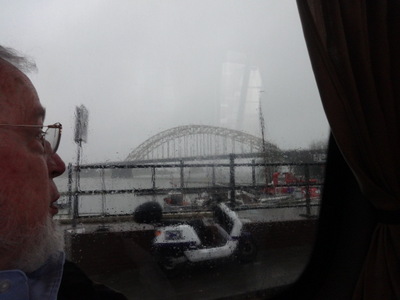 The Allies planned a major offensive, intended to carry Allied troops all the way to the Ruhr valley (a center of German war industry), and the plan chosen for it, devised by General Montgomery, was to advance swiftly and take three key bridges before they could be destroyed, giving the Allies a straight path forward. The operation was code-named Market Garden. One of the three essential bridges was the Waal bridge at Nijmegen.
The Allies planned a major offensive, intended to carry Allied troops all the way to the Ruhr valley (a center of German war industry), and the plan chosen for it, devised by General Montgomery, was to advance swiftly and take three key bridges before they could be destroyed, giving the Allies a straight path forward. The operation was code-named Market Garden. One of the three essential bridges was the Waal bridge at Nijmegen.
The photo at the left is the best shot I could get of that bridge, through the rain-streaked windshield of the bus. It was actually destroyed later but has been rebuilt in the original place and to the original design. During Market Garden, it was successfully taken, and Nijmegen was liberated.
As part of that operation, an initial group of Allied soldiers had to cross the Waal in rowboats, laying a a communications cable on the river bottom as they went, and establishing a beachhead on the town side. Unfortunately, only 26 of the promised 32 boats were safely delivered (late), they turned out to be made of canvas, "some assembly required" (the instructions were not in English), and only four paddles per boat were supplied. The delay cost them the element of surprise and the cover of darkness. The troops had to make the crossing in overloaded boats at 3 pm, in plain view of, and under fire from, the German forces in the town. They made it and were successful, but 48 men died.
To this day, every evening of the year, people of the town walk to the bridge in the Mijmegen Sunset March, where a family member of one of the 48 fallen men illuminates 48 lights on the bridge, one at a time.
Written 15 May 2023
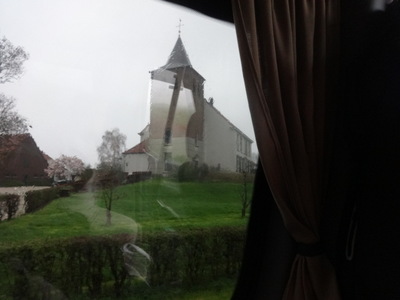 Our bus ride was taking us to the the Vrijheidsmuseum, the Freedom Museum (in Groesbeek), which is dedicated to the liberation of the Netherlands and especially of Nijmegen. I didn't get very many good photos, but our bus ride took us through some beautiful countryside, and we learned a lot from the guide on the way:
Our bus ride was taking us to the the Vrijheidsmuseum, the Freedom Museum (in Groesbeek), which is dedicated to the liberation of the Netherlands and especially of Nijmegen. I didn't get very many good photos, but our bus ride took us through some beautiful countryside, and we learned a lot from the guide on the way:
- Houses are no longer built on the left-hand side of the dike we were driving along the top of, so the houses already there are very expensive. The government is trying to return that area to a natural state and have bought up all the properties they can, but the owners are reluctant to sell.
- If you're lucky you can spot wild Polish horses in the are being restored.
- The area is visited seasonally by geese from 14 different countries.
- They have to cull 3000 wild boar from the nature preserve north of MNijmegen.
The country currently has 21 political parties in the parliament, four in the government. There are 37 in all.
- Before the dike was built, the area had regular seasonal floods, and because their height was pretty predictable, buildings were built on small man-made hills, to keep them above water level. Look, for example, at the church (now actually a private residence) in the photo above. You can't see much of it because of the reflection off the bus window, but you can see that's it's built on its own little hill. In early days, cattle were brought into the church in times of flood.
- In 1995, the flood was especially high: 17 m. Now that summers have become so dry they're looking for ways to store flood water for later use.
- All the way back to the Romans, bricks have been made from the local river clay. Bricks could only be made from April to September, when there was enough sun to dry them. Nine brick factories used to operate here, but now it's down to one,
- We passed many small brick houses, and the guide told us families quite regularly raised up to 12 children in them. Children were the parents' only retirement system.
- Today, retirement age is 67. If you're Dutch and have lived here for 50 years, whether you worked or not, you get a overnment pension at retirement. If you didn't live here that long, your pension payment is reduced somewhat for each year short of 50.
- Housing is chronically in short supply and a constant problem. The government wants 900,000 houses to be built by 2030.
- The Netherlands must take refugees, but the housing shortage makes that difficult. Ukranians are being housed on cruise ships in Nijmegen (I think we saw some of them, with the cruise company logos stripped off). They also have refugees from Syria and Afghanistan. Ukranians are allowed to work, and 90% are working (in restaurants and shops and as drivers; these areas are short-handed), but it can take over 10 years for
Syrians and Turks to get residence and work permits.
- The population density in the Netherlands is 484 people/square kilometer (and the population is still growing). In Germany, it's 282, in Sweden 19, in Finland 17.
- During the cold war, the Netherlands made huge investments in case of Russian invasion. They even made preparations to divert water into the river the Russians would have to cross. It turned out later that the Russians knew all about the whole thing.
- During the five years of occupation of Nijmegen by the Germans during WWII, the guide's parents evaculated. When they came back, the house was empty; everything had been stolen. Someone had reported them killed. They later saw local neighbors using their furniture nd wearing their clothes, but no one offered to return anything. The guide's mother harbored bitter feelings against the Germans for the rest of her life. The Germans also bombed the guide's aunt's house, killing 29 people. It took 30 years to rebuild.
- Many of the houses we passed had thatched roofs. Reeds for thatch must grow in clean water, and this region has very good water quality. The reeds must be cut, by hand, every year, even if they're not needed for thatch, to keep the reed patches healthy. Thatching costs 30 euros/square meter, but it lasts a long time. Insurance on the house is higher because of the risk of fire.
- Engineers claim that water-management works now underway will protect the region for the next 1000 years. They will lower the river by 34 cm
- We passed through the smallest village in the Netherlands, Persingen, with a population of about 100 people.
Finally, I at last got a solid ID of a little shrub that grows in all the fence rows and among the trees alongside the roads, currently covered with little white blossoms. It's hawthorn! That's "meidoorn," i.e. "May thorn," in Dutch. In English, it's also called "May tree," and the French (especially Proust) call it "aubépine, "dawn thorn."
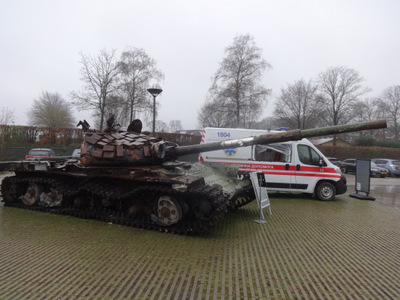
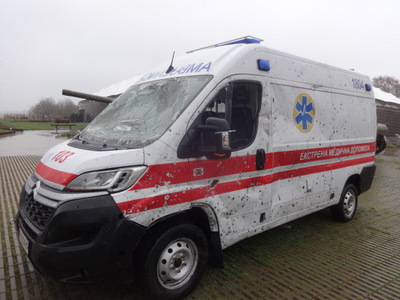 Nijmegen is very close to the German border, and the Vrijheidsmuseum in Groesbeek is even closer, just a couple of miles from Germany, so it gets many German visitors as well.
Nijmegen is very close to the German border, and the Vrijheidsmuseum in Groesbeek is even closer, just a couple of miles from Germany, so it gets many German visitors as well.
Out front were a shot-up and disabled Russian tank and a Ukranian ambulance, sent by the Ukranians. The tank was initially placed in Berlin, with its gun pointed at the front of the Russian embassy, but the Russians were not amused and made a fuss, so they moved it here. It will be displayed here for 45 days.
The photo at the right shows the ambulance from the other side, revealing all the bullet marks and the smashed-in windshield.
The museum recently moved into its snazzy new building, which is actually inflatable. To the left and right of the ambulance, you can see the edges of its roof, intended to evoke the shape of a parachute. The guide started by reassuring us that a safety framework was in place to keep the ceiling from falling on us, in case of the failure of the positive-pressure system that holds it up.
We were astonished to learn that our docent guide, Martin, actually witnessed the battle of Nijmegen personally. The Germans overran Nijmegen and the rest of the Netherlands in 1940, shortly after he was born, so he had never known anything other than German occupation, and he was five years old when operation Market Garden was launched. He saw the sky turn dark with planes and parachutes as the 82nd Airborn dropped from the skies, and he watched the allied troops March over the Waal bridge into the city. He still goes to the sunset march to the bridge two or three times a week. He has been to many reunions of the participants, and he even traveled to Utah once to see one of the paratroopers on his deathbed. Martin assured us that all the parachutes carried real people—Rupert, the dummy parachutist used elsewhere during the war, did not come to Nijmegen.
But he started at the beginning, telling us that Nijmegen goes back to the second century AD. In 104 AD, Emperor Trajan (remember him) renamed the local settlement Ulpia Noviomagus Batavorum (the name "Nijmegen" is derived from "Noviomagus"). He granted it town status in that year, making it the oldest town in the Netherlands.
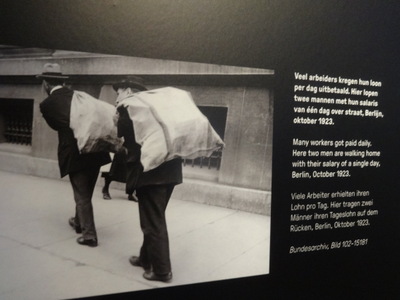
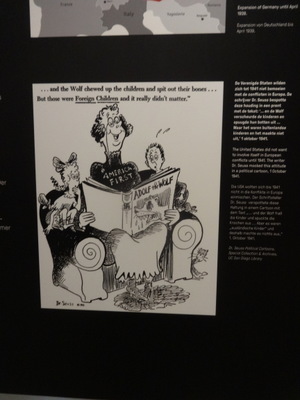 But the guide progressed rapidly to the factors leading up to WWII. After WWI, Germany had to pay all the expenses and reparations, so their economy took a big hit. Before WWI, US$1.00 was worth 4 German marks. In 1920, US$1.00 was worth 420 billion (with a "B") German marks. The period photo at the left is from the 1920's, and it shows workers carrying home their salaries, in cash, from a single day's work, barely enough to buy a day's food.
But the guide progressed rapidly to the factors leading up to WWII. After WWI, Germany had to pay all the expenses and reparations, so their economy took a big hit. Before WWI, US$1.00 was worth 4 German marks. In 1920, US$1.00 was worth 420 billion (with a "B") German marks. The period photo at the left is from the 1920's, and it shows workers carrying home their salaries, in cash, from a single day's work, barely enough to buy a day's food.
Hitler promised to get the Germans out of this mess. He thought Germany should never have surrendered at the end of WWI. And you can see how desperate people must have been to turn things around. Hitler came into power in 1933; the first thing he did was open concentration camps at Dachau.
At the beginning of WWII, the Netherlands were trying to be neutral, so they had no weapons or military preparedness to speak of. Germany simply overran the whole country.
The photo at the right is of a famous 1941 political cartoon by Dr. Suess, mocking Americans' reluctance to join a European war. A woman wearing a sweater saying "America First" is reading to children from a book entitled Adolf the Wolf; the caption reads ". . . and the Wolf chewed up the children and spit out their bones . . . But these were Foreign Children and it really didn't matter."
The museum also includes a wax figure of Thomas Mann. His books were banned in Hitler's Germany, so they were printed in Nijmegen and smuggled into Germany.
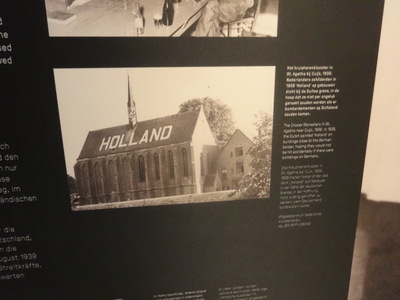
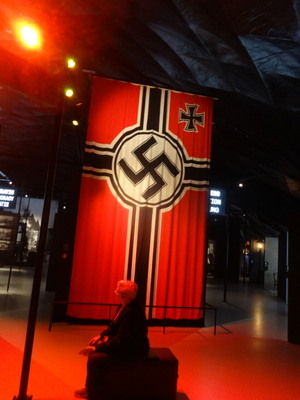 In February of 1944, American bombers got disoriented and mistakenly bombed the center of Nijmegen. The all-clear had sounded after the preceding raid by the Germans, so people were coming out of the shelters. The city center was destroyed, and more than 700 people died. As in Normandy, we were suprised at how little resentment the locals expressed over incidents like this. But the photo at the left shows a precaution taken by a Dutch farmer, hoping bombers wouldn't think his farm was in Germany. More than 6000 airplanes were shot down over the Netherlands alone in the course of the war; 1000 still hven't been found.
In February of 1944, American bombers got disoriented and mistakenly bombed the center of Nijmegen. The all-clear had sounded after the preceding raid by the Germans, so people were coming out of the shelters. The city center was destroyed, and more than 700 people died. As in Normandy, we were suprised at how little resentment the locals expressed over incidents like this. But the photo at the left shows a precaution taken by a Dutch farmer, hoping bombers wouldn't think his farm was in Germany. More than 6000 airplanes were shot down over the Netherlands alone in the course of the war; 1000 still hven't been found.
The museum includes a demonstration bomb shelter with very effective sound effects and vibrations. The guide's mother was in charge of a shelter—24 neighbors would come into their small cellar during raids.
After Nijmegen was liberated, a member of the 82nd Airborne took this Nazi flag from the headquarters of the Luftwaffe, and brought it back to the U.S. as a souvenir. Later, he sent it back, to the museum. German visitors are always shocked to see it, as displaying it would be illegal in Germany.
Operation Market Garden was an allied offensive, proposed by Field Marshall Montgomery and chosen from among several by Eisenhower, that was intended to take three key bridges and provide the allies a direct route to the Ruhr valley, a center of German industrial production, all within 48 hours. "Garden" was the code name for the airborne offensive, and "Market" that of the ground troops. Nijmegen was the first of the three bridges, the second was at Oosterbeek (I think), and the third was at Arnhem. At the time, British Lt. Gen. Frederick Browning said, “I think we might be going a bridge too far.” As it turned out, he was right—Arnhem was a disaster, partly because Montgoermy did not believe the intelligence he received that two large groups of Germans soldiers were resting and regrouping in Arnheim (more in a later diary entry); you've probably heard of the book and the movie called A Bridge Too Far. But the liberation of Nijmegen succeeded. It came at the end of a year of terrible privation for the Dutch people; the railroad workers went on strike to help the allies (and suffered for it at German hands), food supplies were exhausted, and many people starved. Martin remembers the American troops with adulation—they brought chocolate and delectable C-rations!
we're only a short distance from Arnhem, but the troops here did not continue on in that direction. The tanks never advanced without infantry support, and infantry was not allowed to ride on tanks.
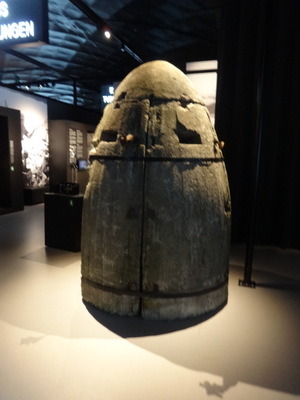
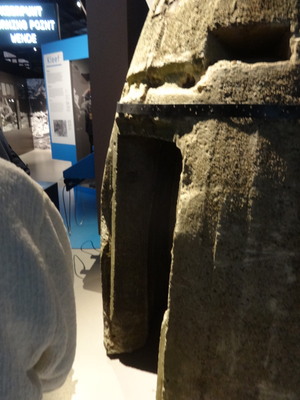 The object in the left-hand photo is a bomb shelter or 2 to 3 people; it's made of thick concrete banded with iron and has tiny slit-like windows. The photo at the right is the lower half of it from the other side, showing the low door through which one ducked to enter.
The object in the left-hand photo is a bomb shelter or 2 to 3 people; it's made of thick concrete banded with iron and has tiny slit-like windows. The photo at the right is the lower half of it from the other side, showing the low door through which one ducked to enter.
Other displays included the metal pipe frame of the cockpit of an American glider, used to bring in troops and supplies, and a Steinway piano was left behind during the evacuation of Nijmegen. It was played by German soldiers and also accidentally shot up a couple of times.
Someone even had the idea that music was a good morale builder, so Steinway developed a portable piano that could withstand the rigors of a parachute landing, and 3000 of them were dropped for use by the Allied troops.

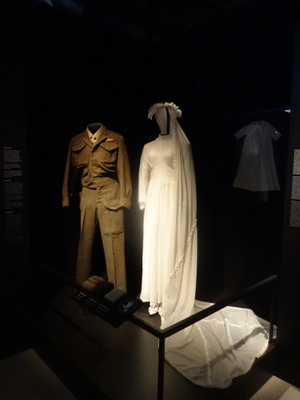 At the left here is a diorama of the initial crossing in canvas boats. It included startling touches of action; for example, the fallen soldier occasionally took a labored breath.
At the left here is a diorama of the initial crossing in canvas boats. It included startling touches of action; for example, the fallen soldier occasionally took a labored breath.
At the right is a wedding gown made from parachute silk after the liberation. They used whatever they had, which wasn't much. Near the wedding gown was a child's sweater spun and knitted from dog hair.
The long period of occupation produced a lot of German babies, because the German soldiers were encouraged to fraternize with and to seduce local girls. After the liberation, parents encouraged their daughters to dance with the American troops, but told them that no kissing was allowed, because by kissing you could get pregnant.
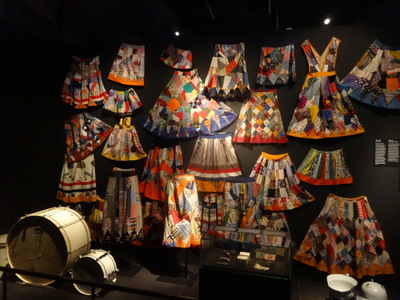
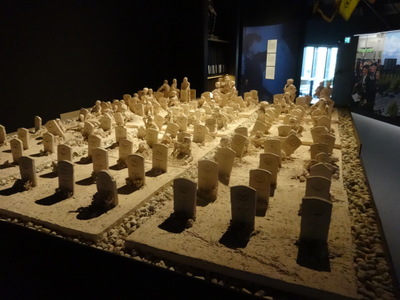 At the left here is another example of making do after the liberation. Fabric was scarce, so old clothes were cut up and any parts not already threadbare were sewn together to make patchwork clothing.
At the left here is another example of making do after the liberation. Fabric was scarce, so old clothes were cut up and any parts not already threadbare were sewn together to make patchwork clothing.
At the right is a very moving work of art the size of a large tabletop. It's by Fransje Povel-Speleers and is called Resurrection. It shows the dead members of the 82nd Airborne awaking and rising from their graves to celebrate the freedom they gave up for that of others. Each figure is a portrait of a real member of the 82nd.
A nearby exhibit illustrated, with a 3D histogram, the numbers from each nationality killed in WWII. In the battle of Nijmegen alone, 1800 Americans and 2000 germans died. I won't list the numbers from each nation, though I have some of them in my notes if you're interested. In all, 80 million people were killed in WWII, of whom only 410,000 were American. Surprisingly, at least to me, millions of Chinese were killed, including many civilians killed by the Japanese.
We also heard about the war on the eastern front. Three million german soldiers walked to Moscow, covering 30 km a day. Unfortunately (for them), they turned south to get coal and food before continuing to Moscow, and the tide turned when winter weather stepped in. On our Viking cruise in Russia in 2017, we heard about the most important member of the Russian defense, "General Frost." The siege of St. Petersburg also failed. According to the guide, 1000 tanks met each other in that series of battles.
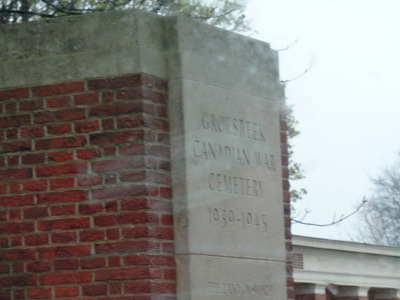
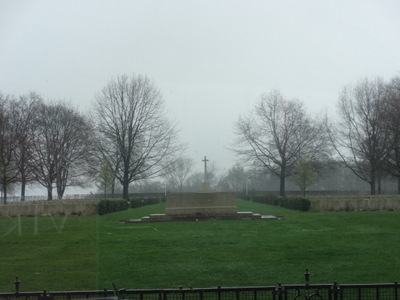 Once back in the bus after our visit to the museum, we stopped briefly at the Canadian War Cemetery at Goresbeek. The Canadians were primary responsible for taking the second bridge, the one beyond Nijmegen. We were running behind schedule (the museum was fascinating), and it was raining, so we didn't get out.
Once back in the bus after our visit to the museum, we stopped briefly at the Canadian War Cemetery at Goresbeek. The Canadians were primary responsible for taking the second bridge, the one beyond Nijmegen. We were running behind schedule (the museum was fascinating), and it was raining, so we didn't get out.
At the left is the sign on the gatepost, and at the right is a view through the gate to the cross at the far end, the beige gravestones to the right and left, and the monolith in the front engraved (as are all those in commonwealth war cemeteries), "Their name liveth for evermore."
Written 17 May 2023
All the Canadian bodies were brought out of Germany and buried in the Netherlands. Many Canadian families chose to have their loved ones brought back for reburial in Canada later. That's why of the 2,600 buried here now, 2,500 are unknown. Farmers plowing in this area still find bodies. The dogtags had only only numbers, not names, so identification has been more complicated.
On the way back to the ship, we actually crossed the border into Germany and back, within 5 minutes, and along one road we drove, houses on the left were in Germany and those on the right in the Netherlands. The houses in Germany actually look different from the Dutch ones, and because they are less expensive, many Dutch people live over the border in Germany and commute to their jobs in the Netherlands. I wonder if that negatively affects the govenment pensions they receive later.
Things we learned on the way back to the ship for lunch:
- Princess Margaret, sister of Queen Beatrix, was actually born in Ottowa during WWII; their hotel room was declared Netherlands territory for the occasion. Margaret came to the grand reopening of the Vrijheidsmuseum in 2019.
- The hills and banks we passed in this area are glacial moraines from from the ice age before last, 1000 years ago, mostly made of sand.
- On our left at one point, the guide pointed out the landing fields for the 82nd Airborne.
- The hilly area is called the gold coast and has beautiful houses built with the wealth extracted from colonies for over 300 years, in the form of tobacco, sugar, spices. They were built here in the hills because the land wasn't good for agriculture. Now a small place with "a garden the size of a towel" costs 426,000 euros—if you can find one, and you usually can't.
- Young people can hardly buy a house, because older richer people always outbid them.
- Princess Magaret owns 342 houses in the Netherlands. (I assume she rents them out.) As of 1 January, when you buy a house, you will have to live in it for 4 years before you can rent it out or sell it.
- Parents can give their children up to 100,000 euros, free of gift tax, so long as it is used to buy a house that will be their primary residence.
- We also passed a reform school, for children up to 15 years old.
- Luxury houses were also built on the ground freed up when they pulled down the Nijmegen city walls in the 19th century.
- I think she said rent for "social housing" was 1000 to 2000 euros/month, but maybe that's the subsidy to those in social housing.
- Nijmegen was one called the Rome of the Netherlands.
- A building we passed that was covered with scaffolding used to be a Jesuit school, unfortunately, one out of which a lot of scandals emerged.
- Nijmegen has the first Catholic univeristy, and you have to be Catholic to go there.
- As they are elsewhere in the Netherlands, coffeeshops are not legal but are tolerated. To enter, you have to be 18. You can buy up to 5 g of cannabis a day, for personal use (and as much actual coffee as you care to drink); the shop can have p to 500 g in stock.
The Netherlands has 400 coffeeshops; Amsterdam has 200 and Nijmegen 14. The ones in Amsterdam also sell cannabis ice cream, lollipops, and coffee.
- The authorities closed down the coffeeshops in the southern part of the country, because they were drawing too many people from other countries who came just to show there.
- Currently, growing cannabis is illegal, but legalization is under discussion. Apparently, in 2 months, from 120 plants, you could earn 6,000 euros. 1 g can cost up to 20 euros for high quality.
- Coffeeshops are worth tolerating because (a) if you buy in the street, you don't really know what you're getting, and (b) collectively, they bring 2 billion euros into the economy annually.
- Three three cities have retirement homes for people addicted to drugs.
- We passed a tower that was part of the 16th-century city wall, but I didn't get a good photo.
- Vlaai is a shallow, lattice-topped fruit pie that is a specialty of this region (Limburg).
My observation: Guides in the Netherlands always say "under" when they mean "below"; it comes up a lot, since sea level is a frequent topic.
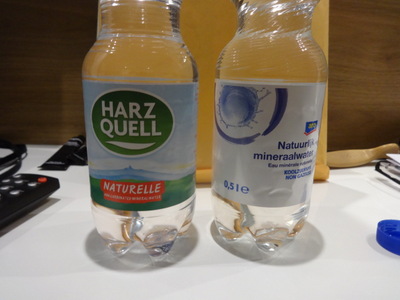
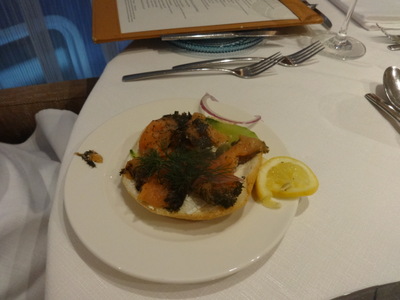 Back at the ship, I took a moment before lunch to photograph these water bottles. The Dutch water on the right, in a bottle with a blue cap, is delicious. That's what we were given on excursions early on this cruise. The German Harz Quell water, in a bottle with a red cap, is dreadful—very sour. The ship loaded a lot of it in Wesel, and that's all they had for excursions thereafter. Yuck.
Back at the ship, I took a moment before lunch to photograph these water bottles. The Dutch water on the right, in a bottle with a blue cap, is delicious. That's what we were given on excursions early on this cruise. The German Harz Quell water, in a bottle with a red cap, is dreadful—very sour. The ship loaded a lot of it in Wesel, and that's all they had for excursions thereafter. Yuck.
Meanwhile, Viking always keeps our cabins supplied with bottled water. On our last cruise, and on the second one of our current back-to-back pair, it's filtered water in tall, heavy glass bottles with shrink-wrap-sealed plastic corks. But on the first of the current pair, it was Italian "Aqua Panna" in liter bottles. I haven't cared for Aqua Panna in the past—oily mouth feel—but these weren't bad at all.
The fine-print appetizers at lunch were potato salad with celery, egg, mustard, and bacon; yesterday's gravlax on a bagel with dill and cucumber; and not-very-Mexican guacamole with pomegranate arils. That's the gravlax to the right of the water bottles.
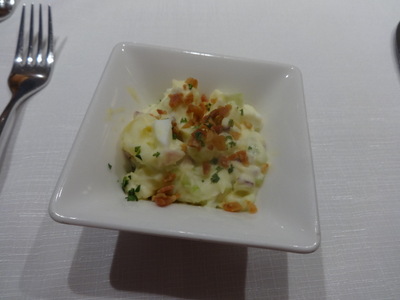
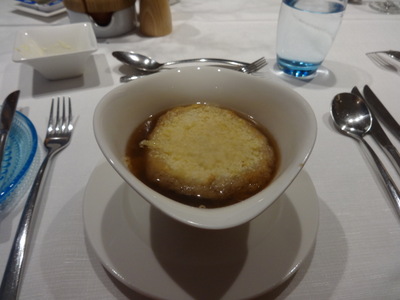 At the left here is the potato salad. It and the gravlax were both excellent.
At the left here is the potato salad. It and the gravlax were both excellent.
At the right is my French onion soup, topped with a rusk and finely grated cheese. Pretty good.
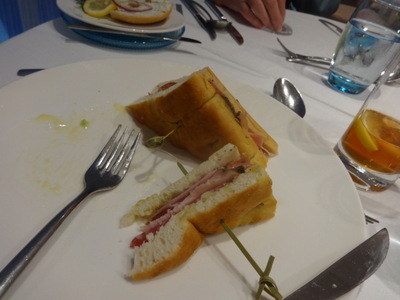
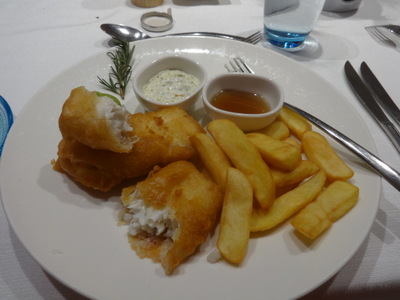 For his main course, David chose the muffuletta sandwich, made on focaccio. He said it wasn't bad but not much like the ones you get in New Orleans.
For his main course, David chose the muffuletta sandwich, made on focaccio. He said it wasn't bad but not much like the ones you get in New Orleans.
I had the fish and chips, made with real Icelandic cod. Quite good and served with both tartare sauce and malt vinegar.
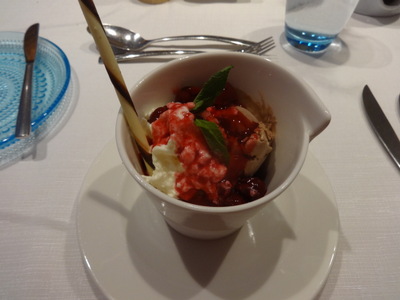
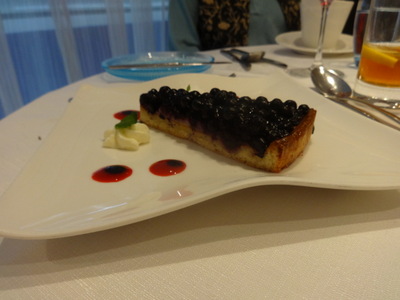 My dessert was called "black forest ice cream," but it was actually chocolate ice cream topped with stewed cherries and whipped cream—I would have called it a black forest sundae.
My dessert was called "black forest ice cream," but it was actually chocolate ice cream topped with stewed cherries and whipped cream—I would have called it a black forest sundae.
David seldom passes up a blueberry dessert, so he chose this blueberry tart with a shortbread crust and raspberry coulis.
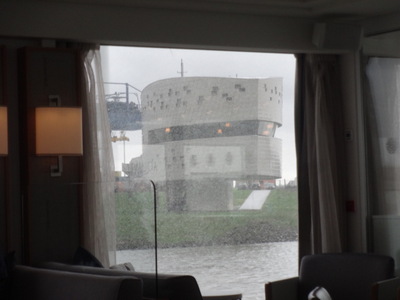
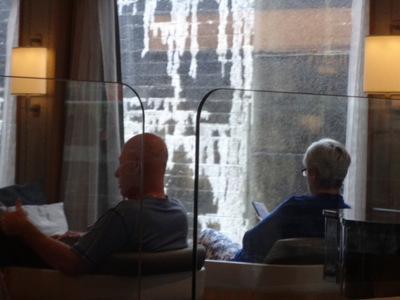 Soon after lunch, we left Nijmegen, heading for Maastricht. Our progress was leisurely. We spent a good while in queues for locks, one of which (after a 20-minute wait), veeerry slowly lowered us six inches before letting us out again. The next one had no queue because it was open at both ends; we just sailed straight throught it.
Soon after lunch, we left Nijmegen, heading for Maastricht. Our progress was leisurely. We spent a good while in queues for locks, one of which (after a 20-minute wait), veeerry slowly lowered us six inches before letting us out again. The next one had no queue because it was open at both ends; we just sailed straight throught it.
Most of the time we were on a canal connecting the Waal with the Maas (which becomes the Meuse when it enters France). The area wasn't very scenic, so the only interesting photos I got in the course of the afternoon were the amazing modern control-tower building shown at the left, which presided over a series of locks, and the heavily white-streaked inside wall of a lock (most of the locks looked like that). I don't think the streaks can be bird droppings. I think they must be minerals (calcium?) leached out of the wall through the joints between the stones. We were just as close to the wall on the other side; clearly only one ship at a time could use these locks.
At least seasonally, they must need locks that deep, but on the day we passed through them, water levels different only slightly if at all.
As we sailed, Program Director Dominic did the usual presentation called "Discover the World of Viking"—you get on one every cruise (we got two since we did two cruises in a row). It consists of slides and videos of other itineraries, lists of promotions and discounts, and an attempt to sell "vouchers" good for other Viking cruises. Each one costs $100 (or 100 of whatever currency you like) and is good for $200 (or 200 of that same currency) off the price of your next cruise. You can buy as many as you want (I understand some people give them as gifts), but you can only redeem one per person on a later cruise. Considering what a small percentage that net $100 discount constitutes of the price of a Viking cruise, we've never considered them worth it.
The highlight of the predinner cocktail hour was that cashews with a cracker-jack-like coating were added to the little trio of munchies they pass around.
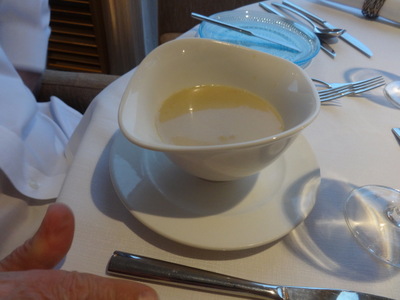
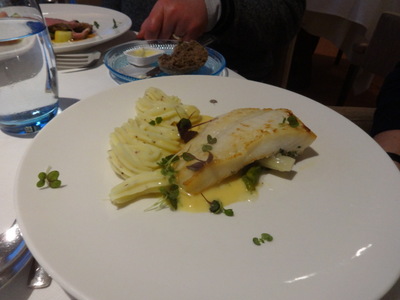 I started dinner with a flammekuche, from the regional-specialities menu (not shown). It was a tasty thing and had all the right toppings on it (caramelized onion, slightly soured cream, cheese, bacon), but it wasn't much like a flammekuche. At home I approximate flammekuchen by making them on flour tortillas, which are only about twice as thick as the crust should be, and crisp them on my pizza stone at 450oF. The Viking chef had used something as thick and chewy as as a pita bread!
I started dinner with a flammekuche, from the regional-specialities menu (not shown). It was a tasty thing and had all the right toppings on it (caramelized onion, slightly soured cream, cheese, bacon), but it wasn't much like a flammekuche. At home I approximate flammekuchen by making them on flour tortillas, which are only about twice as thick as the crust should be, and crisp them on my pizza stone at 450oF. The Viking chef had used something as thick and chewy as as a pita bread!
David had the "tom kha gai," Thai chicken soup with coconut milk and lemongrass.
Someone at the table ordered the seared halibut main course with asparagus and mustard mashed potatoes.
p>
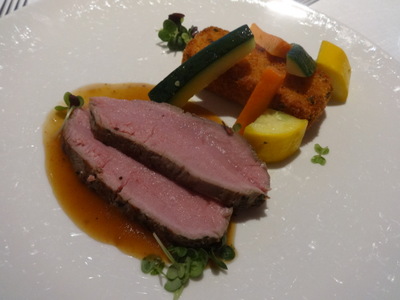
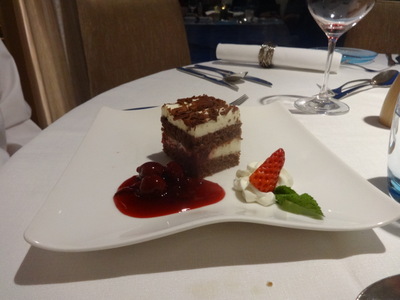 But David and I both had the roast veal sirloin with a log of Parmesan crusted polenta and "seasonal vegetables." It was excellent.
But David and I both had the roast veal sirloin with a log of Parmesan crusted polenta and "seasonal vegetables." It was excellent.
David ordered the black forest cake, shown at the right.
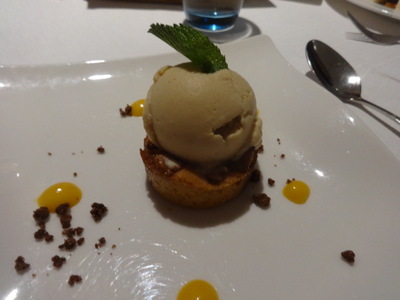
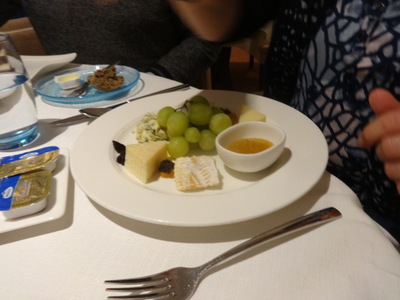 I chose the regional-specialty caramel walnut cake and orange sauce, a yummy little individual muffin with crispy edges and a chewy center, with malt ice cream. I was warned that the malt ice cream would taste like beer, but I love malt (other than in beer), so I tried it anyway and found it quite mild and not beer flavored.
I chose the regional-specialty caramel walnut cake and orange sauce, a yummy little individual muffin with crispy edges and a chewy center, with malt ice cream. I was warned that the malt ice cream would taste like beer, but I love malt (other than in beer), so I tried it anyway and found it quite mild and not beer flavored.
The passenger next to me ordered the cheese plate instead of dessert, and it looked much better than the cheese plates we've seen on other Viking cruises—six widely varied cheeses with fresh and dried fruit and a spicy chutney. It looked so good that I resolved to try it myself some night.
Previous entry
List of Entries
Next entry
 The Allies planned a major offensive, intended to carry Allied troops all the way to the Ruhr valley (a center of German war industry), and the plan chosen for it, devised by General Montgomery, was to advance swiftly and take three key bridges before they could be destroyed, giving the Allies a straight path forward. The operation was code-named Market Garden. One of the three essential bridges was the Waal bridge at Nijmegen.
The Allies planned a major offensive, intended to carry Allied troops all the way to the Ruhr valley (a center of German war industry), and the plan chosen for it, devised by General Montgomery, was to advance swiftly and take three key bridges before they could be destroyed, giving the Allies a straight path forward. The operation was code-named Market Garden. One of the three essential bridges was the Waal bridge at Nijmegen.  Our bus ride was taking us to the the Vrijheidsmuseum, the Freedom Museum (in Groesbeek), which is dedicated to the liberation of the Netherlands and especially of Nijmegen. I didn't get very many good photos, but our bus ride took us through some beautiful countryside, and we learned a lot from the guide on the way:
Our bus ride was taking us to the the Vrijheidsmuseum, the Freedom Museum (in Groesbeek), which is dedicated to the liberation of the Netherlands and especially of Nijmegen. I didn't get very many good photos, but our bus ride took us through some beautiful countryside, and we learned a lot from the guide on the way:
 Nijmegen is very close to the German border, and the Vrijheidsmuseum in Groesbeek is even closer, just a couple of miles from Germany, so it gets many German visitors as well.
Nijmegen is very close to the German border, and the Vrijheidsmuseum in Groesbeek is even closer, just a couple of miles from Germany, so it gets many German visitors as well.
 But the guide progressed rapidly to the factors leading up to WWII. After WWI, Germany had to pay all the expenses and reparations, so their economy took a big hit. Before WWI, US$1.00 was worth 4 German marks. In 1920, US$1.00 was worth 420 billion (with a "B") German marks. The period photo at the left is from the 1920's, and it shows workers carrying home their salaries, in cash, from a single day's work, barely enough to buy a day's food.
But the guide progressed rapidly to the factors leading up to WWII. After WWI, Germany had to pay all the expenses and reparations, so their economy took a big hit. Before WWI, US$1.00 was worth 4 German marks. In 1920, US$1.00 was worth 420 billion (with a "B") German marks. The period photo at the left is from the 1920's, and it shows workers carrying home their salaries, in cash, from a single day's work, barely enough to buy a day's food.
 In February of 1944, American bombers got disoriented and mistakenly bombed the center of Nijmegen. The all-clear had sounded after the preceding raid by the Germans, so people were coming out of the shelters. The city center was destroyed, and more than 700 people died. As in Normandy, we were suprised at how little resentment the locals expressed over incidents like this. But the photo at the left shows a precaution taken by a Dutch farmer, hoping bombers wouldn't think his farm was in Germany. More than 6000 airplanes were shot down over the Netherlands alone in the course of the war; 1000 still hven't been found.
In February of 1944, American bombers got disoriented and mistakenly bombed the center of Nijmegen. The all-clear had sounded after the preceding raid by the Germans, so people were coming out of the shelters. The city center was destroyed, and more than 700 people died. As in Normandy, we were suprised at how little resentment the locals expressed over incidents like this. But the photo at the left shows a precaution taken by a Dutch farmer, hoping bombers wouldn't think his farm was in Germany. More than 6000 airplanes were shot down over the Netherlands alone in the course of the war; 1000 still hven't been found.
 The object in the left-hand photo is a bomb shelter or 2 to 3 people; it's made of thick concrete banded with iron and has tiny slit-like windows. The photo at the right is the lower half of it from the other side, showing the low door through which one ducked to enter.
The object in the left-hand photo is a bomb shelter or 2 to 3 people; it's made of thick concrete banded with iron and has tiny slit-like windows. The photo at the right is the lower half of it from the other side, showing the low door through which one ducked to enter.

 At the left here is a diorama of the initial crossing in canvas boats. It included startling touches of action; for example, the fallen soldier occasionally took a labored breath.
At the left here is a diorama of the initial crossing in canvas boats. It included startling touches of action; for example, the fallen soldier occasionally took a labored breath.
 At the left here is another example of making do after the liberation. Fabric was scarce, so old clothes were cut up and any parts not already threadbare were sewn together to make patchwork clothing.
At the left here is another example of making do after the liberation. Fabric was scarce, so old clothes were cut up and any parts not already threadbare were sewn together to make patchwork clothing. 
 Once back in the bus after our visit to the museum, we stopped briefly at the Canadian War Cemetery at Goresbeek. The Canadians were primary responsible for taking the second bridge, the one beyond Nijmegen. We were running behind schedule (the museum was fascinating), and it was raining, so we didn't get out.
Once back in the bus after our visit to the museum, we stopped briefly at the Canadian War Cemetery at Goresbeek. The Canadians were primary responsible for taking the second bridge, the one beyond Nijmegen. We were running behind schedule (the museum was fascinating), and it was raining, so we didn't get out. 
 Back at the ship, I took a moment before lunch to photograph these water bottles. The Dutch water on the right, in a bottle with a blue cap, is delicious. That's what we were given on excursions early on this cruise. The German Harz Quell water, in a bottle with a red cap, is dreadful—very sour. The ship loaded a lot of it in Wesel, and that's all they had for excursions thereafter. Yuck.
Back at the ship, I took a moment before lunch to photograph these water bottles. The Dutch water on the right, in a bottle with a blue cap, is delicious. That's what we were given on excursions early on this cruise. The German Harz Quell water, in a bottle with a red cap, is dreadful—very sour. The ship loaded a lot of it in Wesel, and that's all they had for excursions thereafter. Yuck.
 At the left here is the potato salad. It and the gravlax were both excellent.
At the left here is the potato salad. It and the gravlax were both excellent.
 For his main course, David chose the muffuletta sandwich, made on focaccio. He said it wasn't bad but not much like the ones you get in New Orleans.
For his main course, David chose the muffuletta sandwich, made on focaccio. He said it wasn't bad but not much like the ones you get in New Orleans.
 My dessert was called "black forest ice cream," but it was actually chocolate ice cream topped with stewed cherries and whipped cream—I would have called it a black forest sundae.
My dessert was called "black forest ice cream," but it was actually chocolate ice cream topped with stewed cherries and whipped cream—I would have called it a black forest sundae.
 Soon after lunch, we left Nijmegen, heading for Maastricht. Our progress was leisurely. We spent a good while in queues for locks, one of which (after a 20-minute wait), veeerry slowly lowered us six inches before letting us out again. The next one had no queue because it was open at both ends; we just sailed straight throught it.
Soon after lunch, we left Nijmegen, heading for Maastricht. Our progress was leisurely. We spent a good while in queues for locks, one of which (after a 20-minute wait), veeerry slowly lowered us six inches before letting us out again. The next one had no queue because it was open at both ends; we just sailed straight throught it.
 I started dinner with a flammekuche, from the regional-specialities menu (not shown). It was a tasty thing and had all the right toppings on it (caramelized onion, slightly soured cream, cheese, bacon), but it wasn't much like a flammekuche. At home I approximate flammekuchen by making them on flour tortillas, which are only about twice as thick as the crust should be, and crisp them on my pizza stone at 450oF. The Viking chef had used something as thick and chewy as as a pita bread!
I started dinner with a flammekuche, from the regional-specialities menu (not shown). It was a tasty thing and had all the right toppings on it (caramelized onion, slightly soured cream, cheese, bacon), but it wasn't much like a flammekuche. At home I approximate flammekuchen by making them on flour tortillas, which are only about twice as thick as the crust should be, and crisp them on my pizza stone at 450oF. The Viking chef had used something as thick and chewy as as a pita bread!
 But David and I both had the roast veal sirloin with a log of Parmesan crusted polenta and "seasonal vegetables." It was excellent.
But David and I both had the roast veal sirloin with a log of Parmesan crusted polenta and "seasonal vegetables." It was excellent.

 I chose the regional-specialty caramel walnut cake and orange sauce, a yummy little individual muffin with crispy edges and a chewy center, with malt ice cream. I was warned that the malt ice cream would taste like beer, but I love malt (other than in beer), so I tried it anyway and found it quite mild and not beer flavored.
I chose the regional-specialty caramel walnut cake and orange sauce, a yummy little individual muffin with crispy edges and a chewy center, with malt ice cream. I was warned that the malt ice cream would taste like beer, but I love malt (other than in beer), so I tried it anyway and found it quite mild and not beer flavored.